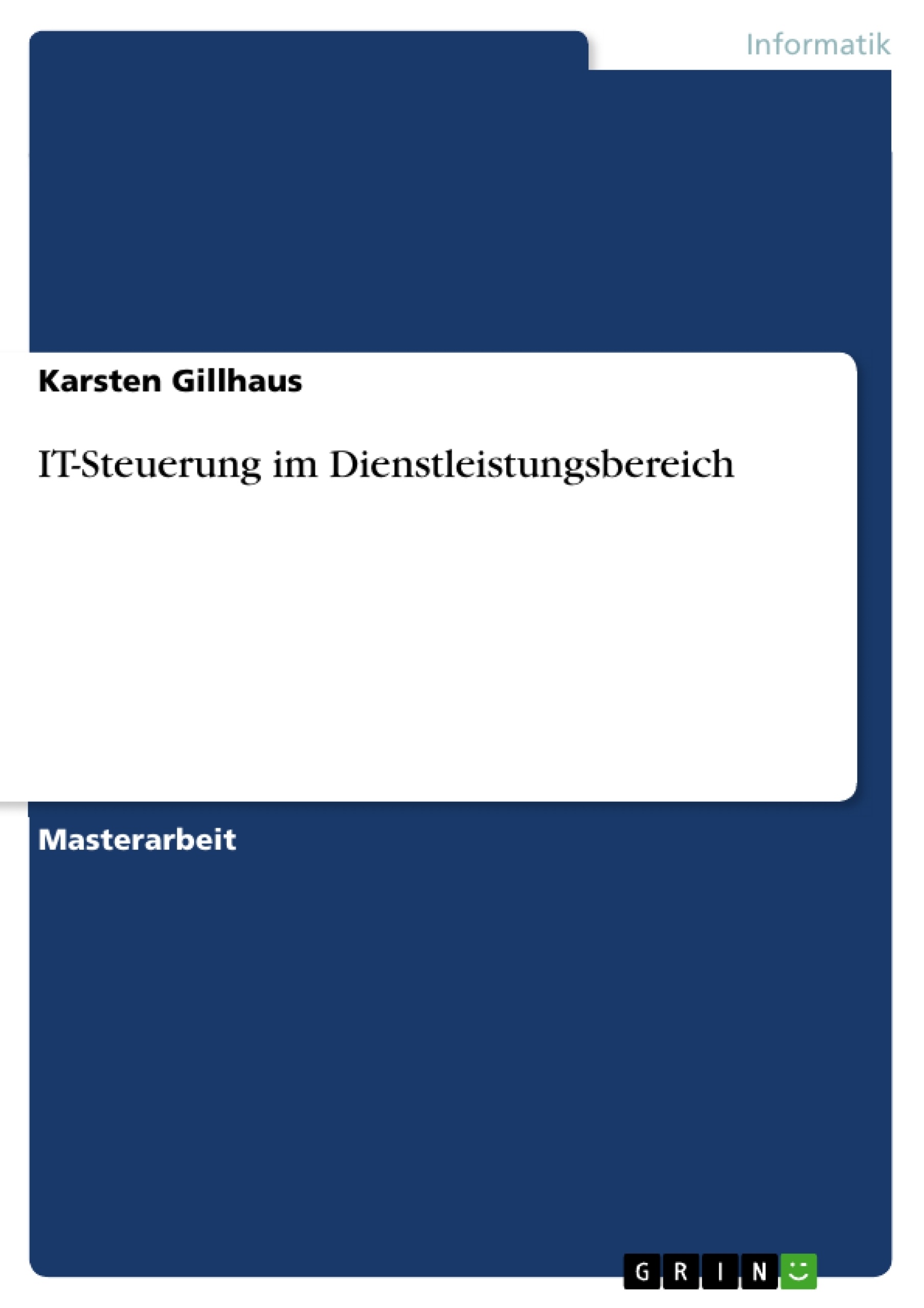Die Arbeit untersucht das Problem der Steuerung von Informations- und Kommunikationstechnik im Dienstleistungsbereich und verfolgt dabei einen interdisziplinären Ansatz. Ausgangspunkt sind das Produktivitätsparadoxon der Informatik und die Softwarekrise. Der Bogen spannt sich von den "Heilslehren" aus Vergangenheit und Gegenwart über die Kybernetik bis zu den offenkundigen Lücken. Das IT-Controlling vergisst, die Anwendung von IT zu steuern. Diese Steuerung wird mit Methoden des Personalmanagements ergänzt. Einen interessanten, weiteren Ansatz bieten Methoden der Simulation, deren Anwendung im Software-Engineering skizziert wird. Ergebnis ist ein Konzept zur IT-Steuerung, das den IT-anwendenden Bereich in die Lage versetzt, seinen IT-Dienstleister in die Dienstleistung zu bringen.
Inhaltsverzeichnis
- 1 Einleitung
- 2 Probleme der Informatik im Dienstleistungsbereich
- 2.1 Betrachtungsraum „Dienstleistungsbereich“
- 2.2 Das Produktivitätsparadoxon
- 2.3 Die Softwarekrise
- 2.4 Paradoxon und Softwarekrise im Zusammenhang
- 3 Management, Steuerung und Controlling
- 3.1 Management
- 3.1.1 Strategisches Management
- 3.1.2 Operatives Management
- 3.2 Controlling und Steuerung
- 3.3 Informationsmanagement
- 3.4 IT-Controlling
- 4 Methoden der IT-Steuerung
- 4.1 „Heilslehren“ oder Technische IT-Steuerung
- 4.1.1 Strukturierte Programmierung und Strukturierte Analyse
- 4.1.2 Software Engineering und Software-Technik
- 4.1.3 Vorgehens- und Prozessmodelle
- 4.1.3.1 Vorgehensmodelle
- 4.1.3.2 Prozessmodelle
- 4.1.3.3 Problematik der Modellverwendung
- 4.1.3.4 Einschub: Projektmanagement
- 4.1.4 Komplexitätsreduktion durch Kapselung
- 4.1.4.1 Datenmodellierung
- 4.1.4.2 Objektorientierung
- 4.1.4.3 Middleware und SOA
- 4.1.4.4 State of the Art
- 4.1.4.5 Industrialisierung der Software-Entwicklung
- 4.1.5 Fazit technische IT-Steuerung
- 4.2 Betriebswirtschaftliche IT-Steuerung
- 4.2.1 IT-spezifische Kennzahlensysteme
- 4.2.2 Kosten- und Leistungsrechnung
- 4.2.3 Zielvereinbarungen
- 4.2.4 Fazit: betriebswirtschaftliche IT-Steuerung
- 4.3 Fazit: Methoden des IT-Controllings
- 5 Lösungsansätze
- 5.1 Was ist Software-Entwicklung?
- 5.2 Human-Resource-orientierte Ansätze
- 5.2.1 Team- und Gruppenarbeit
- 5.2.2 Bereitschaft zum Handeln: Motivation
- 5.2.3 Fähigkeit zum Handeln: Handlungskompetenz
- 5.2.3.1 Fachkompetenz in der Software-Entwicklung
- 5.2.3.2 Sozialkompetenz in der Software-Entwicklung
- 5.2.4 Personalentwicklung durch Schulung
- 5.2.5 Change Management
- 5.3 Ganzheitliche Steuerung
- 5.4 Simulation
- 5.5 Fazit: weitere Konzepte
- 6 Konzeptionelle Anwendung
- 6.1 Konzept und Aufbau der IT-Steuerung
- 6.1.1 Anwendung der Werkzeuge
- 6.1.2 Aufbauorganisation
- 6.2 Vorgehen
- 6.2.1 Strategische, externe Steuerung
- 6.2.2 Strategische, interne Steuerung
- 6.2.3 Operative, interne Steuerung
- 6.2.4 Operative, externe Steuerung
- 6.2.5 Beispiel Finanzbuchhaltung
- 6.3 Zusammenfassung
- 7 Quellen
Zielsetzung und Themenschwerpunkte
Die Masterarbeit befasst sich mit der Steuerung von Informations- und Kommunikationstechnik im Dienstleistungsbereich und verfolgt einen interdisziplinären Ansatz. Sie untersucht das Produktivitätsparadoxon der Informatik und die Softwarekrise, die beide auf mangelnde Produktivität in der Anwendung und Erstellung von IT-Systemen hinweisen.
- Analyse des Produktivitätsparadoxons der Informatik im Dienstleistungsbereich
- Behandlung der Softwarekrise und deren Verbindung zum Produktivitätsparadoxon
- Erörterung von Management- und Controlling-Methoden zur Lösung der Problematik
- Untersuchung technischer und betriebswirtschaftlicher Ansätze zur Steuerung von IT-Systemen
- Entwicklung von Lösungsansätzen für eine effektivere IT-Steuerung im Dienstleistungsbereich
Zusammenfassung der Kapitel
Die Einleitung definiert den Betrachtungsraum „Dienstleistungsbereich“ und führt das Produktivitätsparadoxon der Informatik sowie die Softwarekrise ein. Kapitel 2 analysiert diese beiden Phänomene und zeigt deren Zusammenhang auf. In Kapitel 3 werden Management- und Controlling-Methoden aus Betriebswirtschaftslehre und Wirtschaftsinformatik vorgestellt, darunter Managementlehre, Controlling und Steuerung, Informationsmanagement und IT-Controlling. Kapitel 4 beleuchtet verschiedene Methoden der IT-Steuerung, darunter technische Ansätze wie strukturierte Programmierung, Software Engineering, Vorgehensmodelle und Objektorientierung, sowie betriebswirtschaftliche Ansätze wie IT-spezifische Kennzahlensysteme, Kosten- und Leistungsrechnung und Zielvereinbarungen. Kapitel 5 präsentiert Lösungsansätze für eine effektivere IT-Steuerung, darunter Human-Resource-orientierte Ansätze, ganzheitliche Steuerung, Simulation und weitere Konzepte. Kapitel 6 beschreibt die konzeptionelle Anwendung der entwickelten Steuerungsmodelle und zeigt ein Beispiel für die Steuerung der Finanzbuchhaltung. Schließlich werden im letzten Kapitel die Quellen der Arbeit aufgeführt.
Schlüsselwörter
IT-Steuerung, Dienstleistungsbereich, Produktivitätsparadoxon, Softwarekrise, Management, Controlling, Informationsmanagement, IT-Controlling, Software Engineering, Objektorientierung, Kennzahlensysteme, Kosten- und Leistungsrechnung, Zielvereinbarungen, Human-Resource-Management, ganzheitliche Steuerung, Simulation.
- Quote paper
- Dipl. Kaufmann (FH) Karsten Gillhaus (Author), 2009, IT-Steuerung im Dienstleistungsbereich, Munich, GRIN Verlag, https://www.grin.com/document/140858



